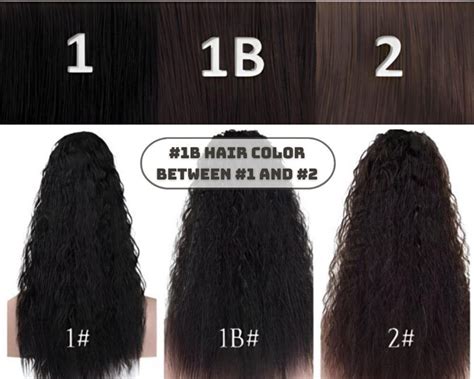1b hair color, a mesmerizing shade of natural ebony, is a captivating feature that exudes elegance and allure. With its rich, ink-like hue, 1b hair turns heads and commands attention.

Understanding 1B Hair Color
1b hair falls under the darkest category on the natural hair color chart. It is characterized by:
- A deep, near-black color with no visible brown or red undertones
- High levels of melanin, the pigment responsible for hair color
- A cool, neutral tone that complements various skin tones
According to the Fitzpatrick Skin Type Scale, individuals with type I or type II skin tones often have 1b hair.
Embracing Your 1B Hair
1b hair is a versatile and stunning hair color that can be styled in countless ways. Whether you prefer sleek, straight locks, luscious curls, or voluminous waves, 1b hair effortlessly embraces any hairdo.
-
Natural Beauty: 1b hair’s natural ebony shade exudes a sense of confidence and allure. It requires minimal maintenance and upkeep, showcasing the beauty of your natural locks.
-
Versatility: 1b hair serves as a blank canvas for various hair colors and styles. From vibrant hues to subtle highlights, this hair color complements a wide range of looks.
-
Cultural Significance: 1b hair holds deep cultural and historical significance for African and Asian communities. It is associated with strength, beauty, and a connection to one’s roots.
Caring for 1B Hair
Proper hair care is essential for maintaining the health and shine of 1b hair. Consider the following tips:
-
Moisturize Regularly: 1b hair tends to be on the drier side, so regular moisture is crucial. Use moisturizing shampoos, conditioners, and hair masks to keep your locks hydrated.
-
Protect from Heat: Heat styling can damage 1b hair, so use heat protectant products and limit the use of hot tools.
-
Trim Regularly: Split ends can dull the appearance of 1b hair. Regular trims will remove damaged hair and keep your locks looking vibrant.
Coloring 1B Hair
While 1b hair is naturally dark, it can be colored to create various looks. However, it is important to note that coloring 1b hair requires special techniques and professional expertise.
-
Lightening: Lightening 1b hair is a challenging but achievable process. It requires multiple bleaching sessions using specialized bleach formulations.
-
Highlighting: Adding highlights to 1b hair can add dimension and depth. Foiling techniques are commonly used to achieve subtle or bold highlights.
-
Toning: Toning is a process that deposits color onto 1b hair without lightening it. This technique can enhance the natural ebony shade or add a hint of warmth or coolness.
Common Concerns with 1B Hair
Like any hair type, 1b hair has specific concerns that need to be addressed:
Dryness: 1b hair tends to be drier due to its low porosity. Dryness can lead to frizz, breakage, and a dull appearance.
Tangling: The natural texture of 1b hair can make it prone to tangles, especially when dry. Regular detangling and the use of detangling products are essential.
Over-Processing: Excessive coloring or bleaching can damage 1b hair. It is crucial to work with a skilled hair stylist to minimize the risk of damage.
Innovative Uses for 1B Hair
Beyond its aesthetic appeal, 1b hair has potential applications in various fields:
-
Hair extensions: 1b hair is highly sought-after for hair extensions, as it blends seamlessly with natural dark hair.
-
Wigs and hairpieces: 1b hair is used to create realistic wigs and hairpieces that provide natural-looking coverage.
-
Medical applications: 1b hair has been explored as a potential source for tissue engineering and regenerative medicine.
Conclusion
1b hair color is a stunning and versatile hair color that evokes a sense of confidence and natural beauty. By understanding its unique characteristics and embracing proper hair care practices, individuals with 1b hair can unlock its full potential. Whether you prefer its natural ebony shade or opt for creative coloring techniques, 1b hair is a true embodiment of
